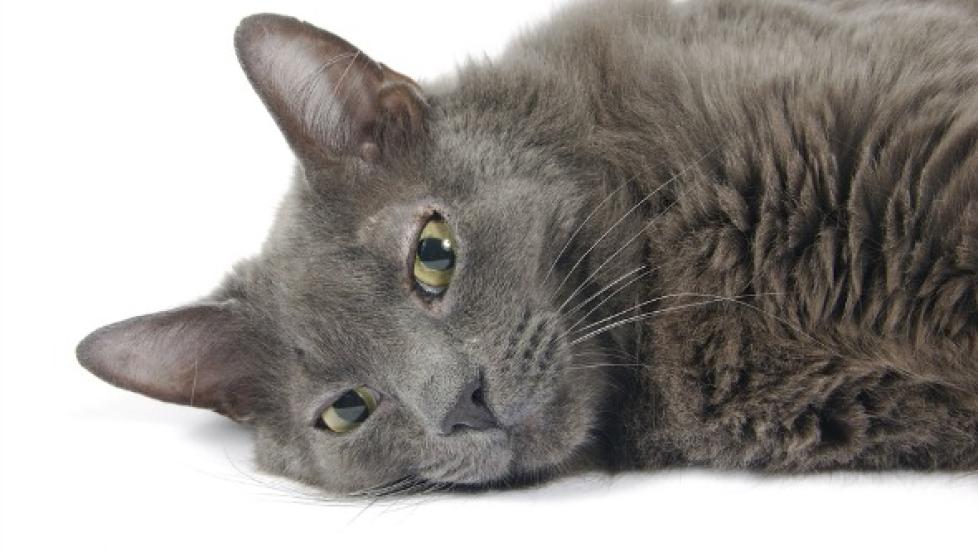Gallbladder and Bile Duct Inflammation in Cats
Cholecystitis and Choledochitis in Cats
All of the components of this digestive system work in tandem, and if one fails to function properly, the result is that most of the body will suffer ill effects. The gallbladder rests in the abdomen, firmly affixed to the liver and serving as a storage receptacle for bile, a fluid that is essential for digesting food in the stomach and intestines. The bile duct transports bile from the liver into the gallbladder and into the small intestine, and the liver functions in the secretion of the bile. Inflammation of the gallbladder is often associated with obstruction and/or inflammation of the common bile duct and/or the liver/bile system, and is sometimes associated with gallstones. Severe cases of inflammation can result in rupture of the gallbladder and subsequent severe inflammation of the bile duct (bile peritonitis), necessitating combined surgical and medical treatments.
There is no direct association with breed, gender, or age.
Symptoms and Types
Some of the symptoms that can be indicative of an inflamed gallbladder or bile duct are sudden loss of appetite, lethargy, vomiting, and abdominal pain. Mild to moderate jaundice with concurrent fever is commonly associated with conditions of the bile duct. Look for yellow eyes and yellowing of the gums. Shock due to infection and reduction in blood volume can also occur. Signs of shock include shallow breathing, hypothermia, pale or gray gums, and a weak but rapid pulse. Inflammation and adhesions involving the gallbladder and adjacent tissues can lead to swelled tissue; a palpable mass of tissue will be felt in the upper right abdomen, especially in small sized cats.
Causes
The causes for an inflamed gallbladder or bile duct can result from one or more conditions that will lead up to it. Muscles in the gall bladder may be malfunctioning, which can lead to impaired bile flow in the cystic duct or gall bladder, irritating the walls of the gallbladder. Or the blood supply to the gallbladder wall is being restricted, in which case the cause for the restriction must be isolated and treated to improve the blood flow. Irritants in the bile can cause the bile duct to be overly sensitive and reactive; a backward flow of pancreatic enzymes may trigger and intensify inflammation. Previous abdominal surgery, or trauma to the abdomen, can directly lead to internal sensitivity, affecting one or more of the internal organs, including the liver and gallbladder.
Your veterinarian will look for some of the more common intestinal disorder to confirm or rule out, such as bacterial infections originating in the intestine or bloodstream, invading the gallbladder. Escherichia coli (E. coli), is a normal part of the bacterial flora in the gut, which protects the intestines from harmful bacteria, but that can occasionally become a problem, depending on the strain of E.coli. Emphysematous cholecystitis is a complicated, acute gall bladder inflammation characterized by the presence of gas in the gallbladder wall, and is associated with diabetes mellitus. This condition is associated with a traumatic restriction of blood flow to the gall bladder and acute gall bladder inflammation with or without stones. Gas-forming organisms and E. coli are often cultured; emphysematous cholecystitis is rare.
Other rare causes that your veterinarian will want to rule out are abnormal gall bladder development, and parasites of the bile duct (biliary coccidiosis).
Diagnosis
Your veterinarian will order blood and urinalysis tests. X-rays and/or ultrasound images of the abdomen, to get a clearer image of the internal system, is also likely to be one of the diagnostic tools used pretreatment. Using diagnostic and differential testing, your doctor will rule out the following possible causes for the symptoms:
- Pancreatitis
- Focal or diffuse peritonitis
- Bile peritonitis (inflammation of the lining of the bile duct, or the vicinity)
- Gastroenteritis with secondary biliary tract involvement (inflammation of the stomach and intestines, spreading into the bile duct)
- Stones in the gallbladder
- Cholangiohepatitis (inflammation of the system that carries bile and the surrounding liver tissue)
- Cell destruction in the liver
- Abscess in the liver
- Blood poisoning
- Metastatic cancer
- Accumulation of thickened bile in the gall bladder
Treatment
If your cat's condition is not life threatening or severe, outpatient care may include antibiotics or other medications to dissolve the gallstones. For the more serious, critical complications, inpatient care will be required. During diagnostic and presurgical evaluations, restoring fluid and electrolyte balances as necessary, and monitoring electrolytes frequently will be essential for stabilizing your cat in the early phase of treatment. Other treatments that may be indicated are intravenous fluids, plasma (if indicated), and whole blood transfusion if your cat has bleeding tendencies, or if it has lost blood internally or externally.
If your veterinarian finds that surgery will be needed, a gallbladder resection may be recommended. Urine output will be monitored as part of evaluating the body's ability to restore and retain fluids. Remain observant for a slowed heartbeat, drop in blood pressure, and cardiac arrest when biliary structures are manipulated. Atropine may be required to slow or prevent the organs from responding to nerve stimulation, and to slow the body's secretions.
Your veterinarian may also prescribe the following drugs: presurgery antibiotics, medication to dissolve gallstones, and Vitamin K1.
Living and Management
Physical examinations and pertinent diagnostic testing will be prescribed by your veterinarian -- repeating every two to four weeks until normal results are regular. Be prepared for possible complications or recurrences, and be attentive of your pet during the healing stage. A ruptured biliary tract (bile system) and/or peritonitis may complicate and prolong your cat's recovery.
Help us make PetMD better
Was this article helpful?
